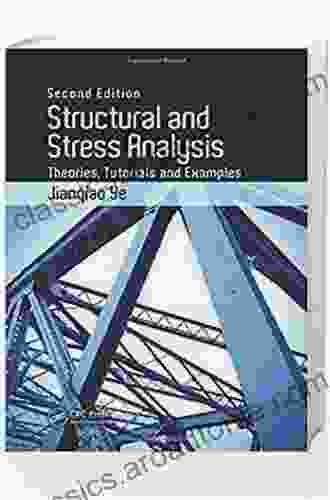Structural and Stress Analysis: A Comprehensive Guide for Mastering Engineering Design

In the realm of engineering, structural and stress analysis hold immense significance. They provide engineers with the essential knowledge and tools to design and construct structures that are both safe and efficient. This comprehensive article delves into the intricacies of structural and stress analysis, providing a thorough understanding of its key concepts and methodologies. Through detailed explanations, real-world examples, and a blend of theoretical and practical approaches, this article aims to equip engineers with the expertise they need to excel in this crucial field.
4 out of 5
| Language | : | English |
| File size | : | 11045 KB |
| Screen Reader | : | Supported |
| Print length | : | 278 pages |
Understanding Structural Analysis
Structural analysis involves examining the behavior of structures under various loading conditions. It seeks to determine the internal forces, stresses, and deformations that occur within a structure, enabling engineers to assess its overall stability and performance. The foundation of structural analysis lies in understanding the principles of statics and mechanics of materials. By applying these principles, engineers can analyze the forces acting on a structure, calculate the resulting stresses, and predict its response to external loads.
Types of Structural Analysis
Structural analysis encompasses various methods, each tailored to specific types of structures and loading conditions. Common methods include:
- Static analysis: Considers the effects of constant or gradually applied loads, such as dead loads (e.g., the weight of the structure itself) and live loads (e.g., occupants or equipment).
- Dynamic analysis: Evaluates the response of structures to time-varying loads, such as earthquakes, wind, or vibrations.
li>Nonlinear analysis: Captures the behavior of structures under nonlinear conditions, such as material yielding or geometric imperfections.
Stress Analysis and its Importance
Stress analysis is an integral part of structural analysis. It involves determining the distribution and magnitude of stresses within a structure under various loading conditions. Stress analysis enables engineers to identify critical areas where high stresses are likely to occur, allowing them to design for adequate strength and prevent structural failure.
Types of Stresses
There are different types of stresses that can act on a structure, including:
- Tensile stress: When a force is applied to stretch or elongate a material.
- Compressive stress: When a force is applied to shorten or compress a material.
- Shear stress: When a force is applied parallel to the surface of a material, causing it to slide or deform.
- Bending stress: When a force is applied perpendicular to the axis of a beam or column, causing it to bend.
- Torsional stress: When a force is applied to twist or rotate a material.
Stress Concentration and its Implications
Stress concentration occurs when a discontinuity in a structure, such as a hole, notch, or sharp corner, causes a localized increase in stress. These areas of high stress are potential failure points, so engineers must carefully consider stress concentrations during the design process.
Analytical and Numerical Methods in Structural Analysis
Structural and stress analysis can be performed using both analytical and numerical methods. Analytical methods involve solving mathematical equations to determine the behavior of a structure. While analytical methods are often more accurate, they can be complex and time-consuming for complex structures. Numerical methods, such as the finite element method (FEM),approximate the behavior of a structure by dividing it into smaller elements and solving equations for each element. FEM is widely used in industry due to its versatility and ability to handle complex geometries and loading conditions.
Applications of Structural and Stress Analysis
Structural and stress analysis have numerous applications in engineering design, including:
- Civil engineering: Designing bridges, buildings, dams, and other infrastructure projects.
- Mechanical engineering: Analyzing machine components, pressure vessels, and aircraft structures.
- Aerospace engineering: Designing aircraft wings, fuselages, and engine components.
- Biomedical engineering: Studying the mechanics of bones, muscles, and implants.
Structural and stress analysis are essential disciplines in engineering design, providing engineers with the ability to create structures that are safe, efficient, and reliable. Through a comprehensive understanding of the principles and methodologies involved, engineers can harness the power of structural and stress analysis to design and build structures that withstand the challenges of the real world. By constantly pushing the boundaries of knowledge and innovation, engineers can continue to advance the field of structural and stress analysis, shaping the future of engineering design and construction.
4 out of 5
| Language | : | English |
| File size | : | 11045 KB |
| Screen Reader | : | Supported |
| Print length | : | 278 pages |
Do you want to contribute by writing guest posts on this blog?
Please contact us and send us a resume of previous articles that you have written.
 Book
Book Novel
Novel Page
Page Chapter
Chapter Text
Text Story
Story Genre
Genre Reader
Reader Library
Library Paperback
Paperback E-book
E-book Magazine
Magazine Newspaper
Newspaper Paragraph
Paragraph Sentence
Sentence Bookmark
Bookmark Shelf
Shelf Glossary
Glossary Bibliography
Bibliography Foreword
Foreword Preface
Preface Synopsis
Synopsis Annotation
Annotation Footnote
Footnote Manuscript
Manuscript Scroll
Scroll Codex
Codex Tome
Tome Bestseller
Bestseller Classics
Classics Library card
Library card Narrative
Narrative Biography
Biography Autobiography
Autobiography Memoir
Memoir Reference
Reference Encyclopedia
Encyclopedia Jerry Minchey
Jerry Minchey Sharon Promislow
Sharon Promislow Shirlee Mccoy
Shirlee Mccoy Ann Rinaldi
Ann Rinaldi Andrew Uyal
Andrew Uyal Amy Nicholas
Amy Nicholas Amy Ippoliti
Amy Ippoliti Anil K Chopra
Anil K Chopra Frank Martela Ph D
Frank Martela Ph D Mike Smart
Mike Smart Andrew Watt
Andrew Watt Angela Williamson
Angela Williamson Anders Skrondal
Anders Skrondal Angela Taibo
Angela Taibo Andrew Rankin
Andrew Rankin Andrew Revkin
Andrew Revkin Andrei Guruianu
Andrei Guruianu Angelique Stefan
Angelique Stefan Amy Daniels
Amy Daniels Katie Henry
Katie Henry
Light bulbAdvertise smarter! Our strategic ad space ensures maximum exposure. Reserve your spot today!

 Carlos FuentesMagick, Rock and Roll, and the Wickedest Man in the World: An Unforgettable...
Carlos FuentesMagick, Rock and Roll, and the Wickedest Man in the World: An Unforgettable... Leo TolstoyFollow ·3.3k
Leo TolstoyFollow ·3.3k Ivan TurnerFollow ·2.4k
Ivan TurnerFollow ·2.4k J.D. SalingerFollow ·16.8k
J.D. SalingerFollow ·16.8k Orson Scott CardFollow ·11.9k
Orson Scott CardFollow ·11.9k Deacon BellFollow ·2.2k
Deacon BellFollow ·2.2k Neal WardFollow ·6.4k
Neal WardFollow ·6.4k Calvin FisherFollow ·8k
Calvin FisherFollow ·8k Everett BellFollow ·2.8k
Everett BellFollow ·2.8k

 Braden Ward
Braden WardThe True Story of Murder and Betrayal
In a small town where...

 W. Somerset Maugham
W. Somerset MaughamUnraveling the Complexities of Human Language: A...
Language is a fundamental aspect of human...

 Ibrahim Blair
Ibrahim BlairTrue Crime Tales That Will Keep You on the Edge of Your...
Prepare to be...

 Rick Nelson
Rick NelsonPatterns In Rhyme: A Journey of Discovery with Patrick...
Welcome to the...

 Edgar Hayes
Edgar HayesWithout Pity: Unmasking the Evil Within
In the realm of true...

 Cooper Bell
Cooper BellFannie Lou Hamer's Indelible Legacy: Unraveling the...
The Black Freedom Movement, a pivotal...
4 out of 5
| Language | : | English |
| File size | : | 11045 KB |
| Screen Reader | : | Supported |
| Print length | : | 278 pages |










